The first eight of these posts were made by several people regarding this subject. However they were located in Engine Conversions under the title of "Twin Spark head on 2L Nord Block".

What the stock 75 TS Motronic can and cannot do.
61 - 80 of 817 Posts
Joined
·
3,589 Posts
InstiTS, thank you for your observations regarding the Squadra chip. The initial rough idle concerns me a bit, but this might be unique to your car...or not.
I'll be using an oxygen sensor, but no cat. In California, if your car is a '75 or older, it no longer needs to be tested.
Do you have any guesstimate as to what would happen if injectors with a slightly higher flow rate were installed with the chip? Or do you feel the stock ones are more than adequate?
I'll be using an oxygen sensor, but no cat. In California, if your car is a '75 or older, it no longer needs to be tested.
Do you have any guesstimate as to what would happen if injectors with a slightly higher flow rate were installed with the chip? Or do you feel the stock ones are more than adequate?
Joined
·
70 Posts
I think it's safe to say if you have a pretty standard exhaust system (with cat) and use Squadra + 97RON setting, you will be okay with idle, however you will probably kill the cat quickly because no lambda control (always open loop). The white car has been set like this for I don't know how long and I look forward to giving it a hard time at some trackdays in the future!InstiTS, thank you for your observations regarding the Squadra chip. The initial rough idle concerns me a bit, but this might be unique to your car...or not.
I'll be using an oxygen sensor, but no cat. In California, if your car is a '75 or older, it no longer needs to be tested.
Do you have any guesstimate as to what would happen if injectors with a slightly higher flow rate were installed with the chip? Or do you feel the stock ones are more than adequate?
As I said, when the red car is set to 95RON closed loop (yellow) and only idles rough for a second or two, it's probably barely noticable by most people's standards. This believed would be the most reliable economy/power setting due to being the highest octane that still used lambda control.
I would think the stock injectors are more than adequate for the chip alone... I believe the 155 TS only really needed larger injectors around the 170hp mark (based on another forum poster's observations).
I recommend going for the chip anyway and just fine tuning the fuel quality plug with your own observations, particularly because you don't have a cat. Give 97RON a go first and see if it idles nicely, if not, 95RON without lambda control, then 95RON with lambda and so forth.
Joined
·
520 Posts
Is the eprom really soldered in? I had assumed it would be socketed?
I think I can make a tune for 97RON closed loop easy enough as a starting point, if the eprom was socketed I could post you a dual-tune chip to try out.
If it's soldered in, the ecu would need to have a socket installed first which is a little more invasive...
I think I can make a tune for 97RON closed loop easy enough as a starting point, if the eprom was socketed I could post you a dual-tune chip to try out.
If it's soldered in, the ecu would need to have a socket installed first which is a little more invasive...
Joined
·
70 Posts
I told my mechanic who fitted it a year or two back that it was probably exchangable without soldering... but he had to send it off to an instruments specialist to have it 'soldered' in, and also he mentioned some tamper/security tag needed to be removed first?
that would be awesome to try out on the stock ECU though, it only cost about 30 dollars to have it soldered in. Surely the eprom that you would burn would be just the same?
that would be awesome to try out on the stock ECU though, it only cost about 30 dollars to have it soldered in. Surely the eprom that you would burn would be just the same?
Joined
·
520 Posts
I've been working my way through the rev limiter functions this afternoon.
My guess is that these have a sort of 2 stage limiter - a soft limit of around 6200(?)rpm that you're allowed to exceed for a second or two before it kicks in, and a hard limit of ~6600 rpm?
Does that sound about right?
Edit: I found a reference to the rev limiters on the squadra site, 6300/6600 so that's reassuring
My guess is that these have a sort of 2 stage limiter - a soft limit of around 6200(?)rpm that you're allowed to exceed for a second or two before it kicks in, and a hard limit of ~6600 rpm?
Does that sound about right?
Edit: I found a reference to the rev limiters on the squadra site, 6300/6600 so that's reassuring
Joined
·
70 Posts
Afaik, factory limit is 6800, which Squadra have raised to 7200 on my chip.
embarrassingly I don't think I have hit the limiter in either car as of yet (don't trust the tacho that much)... I get the feeling it sort of just flattens out at redline anyway, might as well shift at ~6k... obviously not the attitude in competition driving!
Well, you're certainly moving your way through the binaries. If you're fairly confident about making a chip, I don't mind paying to have it soldered for kicks.
embarrassingly I don't think I have hit the limiter in either car as of yet (don't trust the tacho that much)... I get the feeling it sort of just flattens out at redline anyway, might as well shift at ~6k... obviously not the attitude in competition driving!
Well, you're certainly moving your way through the binaries. If you're fairly confident about making a chip, I don't mind paying to have it soldered for kicks.
Joined
·
520 Posts
I've set the rev limit parameters up with the soft limiter being an on/off setting, and the hard limiter set by rpm.
The soft limiter disable method I came up with is a little... umm... unconventional, but looks to do the job well
The soft limiter disable method I came up with is a little... umm... unconventional, but looks to do the job well
Attachments
-
17.5 KB Views: 1,529
Joined
·
520 Posts
I was reading through a couple of old threads this morning, and saw that El Barto had run into the checksum issue while trying to edit his maps some time back.
Calculating the checksum appears to be pretty straight forward - it's stored as a 16 bit integer at 0x7F00 (right before the ECU part number), and is calculated by taking the lowest 16 bits of the sum of all bytes 0x0000 to 0x7EFF.
I'm using the free ecu editor program 'Tuner Pro' and have my ECU definition now calculating the correct checksum for me.
I've tested it by changing rev limiter settings and noting the new checksum, then changing the rev limit back to factory default and checking that the checksum matches the original rom image.
What this means is that the checksum is taken care of behind the scenes, rather than having to manually calculate it.
Calculating the checksum appears to be pretty straight forward - it's stored as a 16 bit integer at 0x7F00 (right before the ECU part number), and is calculated by taking the lowest 16 bits of the sum of all bytes 0x0000 to 0x7EFF.
I'm using the free ecu editor program 'Tuner Pro' and have my ECU definition now calculating the correct checksum for me.
I've tested it by changing rev limiter settings and noting the new checksum, then changing the rev limit back to factory default and checking that the checksum matches the original rom image.
What this means is that the checksum is taken care of behind the scenes, rather than having to manually calculate it.
Joined
·
3,589 Posts
festy, I should go back and check, but how are you doing this without the Motronic ECU? Did you find a complete, umm, readout on the Internet?
How deep into the program are you on a percentage basis? Or is it an almost never ending series of 'rooms'...or should I say, an enigma within an enigma within...?
Do you know of someone who has a running TS installed who might be willing to be a beta tester (or would it be alpha tester)? Others might not agree, but it would be great (for me) if someone has rebuilt theirs using 10.5:1 pistons, had everything balanced, and the flywheel lightened a bit. I realize the latter does nothing but make the engine rev more easily.
Jim K once again I want to thank you for commenting that there are no aftermarket electronic systems that covers as many aspects of the running of the engine than the stock one's do. Okay, poor terminology on my part. It gives me a better feeling that sticking with the Motronic system is the wise thing to do - short of someone who has modified their TS beyond what the stock unit could handle.
And again, this technical part is so beyond me - and I suspect a few others - but think it is nifty that there are several here who do have a working knowledge of the 'inner workings' of the Motronic ECU.
How deep into the program are you on a percentage basis? Or is it an almost never ending series of 'rooms'...or should I say, an enigma within an enigma within...?
Do you know of someone who has a running TS installed who might be willing to be a beta tester (or would it be alpha tester)? Others might not agree, but it would be great (for me) if someone has rebuilt theirs using 10.5:1 pistons, had everything balanced, and the flywheel lightened a bit. I realize the latter does nothing but make the engine rev more easily.
Jim K once again I want to thank you for commenting that there are no aftermarket electronic systems that covers as many aspects of the running of the engine than the stock one's do. Okay, poor terminology on my part. It gives me a better feeling that sticking with the Motronic system is the wise thing to do - short of someone who has modified their TS beyond what the stock unit could handle.
And again, this technical part is so beyond me - and I suspect a few others - but think it is nifty that there are several here who do have a working knowledge of the 'inner workings' of the Motronic ECU.
Joined
·
520 Posts
With great difficultyfesty, I should go back and check, but how are you doing this without the Motronic ECU?
I found a schematic diagram of the ML4.1, so can trace some of the peripheral connections back to the CPU, then hunt for references to that hardware port to narrow down the different functions.
Yes, I've got hold of a couple of eprom dumps from various 75s/164s - the one I'm concentrating on is version 1267356191 (ECU 0261200108), mask 021F.Did you find a complete, umm, readout on the Internet?
I'm picking away at bits of 'obvious' code (easy wins) and hunting for the 'interesting' functions - sort of prioritising the battle.How deep into the program are you on a percentage basis? Or is it an almost never ending series of 'rooms'...or should I say, an enigma within an enigma within...?
There's so much in these, that I doubt I'll ever completely work it all out.
For instance, the different fuel/lambda settings effectively quadruple the program, something as simple as determining the spark advance has maybe a hundred branches in the code, I'm slowly working through what each of these concerns and haven't even got to the tables each consults yet
Having a TS to test with would certainly make this easier, but unfortunately I don't have that option.Do you know of someone who has a running TS installed who might be willing to be a beta tester (or would it be alpha tester)? Others might not agree, but it would be great (for me) if someone has rebuilt theirs using 10.5:1 pistons, had everything balanced, and the flywheel lightened a bit. I realize the latter does nothing but make the engine rev more easily.
The engine mods are meaningless for the ECU mapping, changing cams/compression/injectors etc won't make any difference to what the ECU code does. Obviously if I was to try and edit the tables to suit a modified engine then having one on hand would be best, but I'm aiming more towards a simple DIY tuning interface rather than making chips for people.
The ML4.1 will never be suitable for a MAP based system, and the rev limit can't be pushed too much higher due to the slow CPU (it has to count a lot of teeth per RPM!) - so although it does a lot more than an aftermarket, it's not cutting edge technology and has it's limitations. For a race engine, I wouldn't use one of these - and honestly, if I owned a TS I would ditch the ECU and use a MAP based system like is on my alfetta.Jim K once again I want to thank you for commenting that there are no aftermarket electronic systems that covers as many aspects of the running of the engine than the stock one's do. Okay, poor terminology on my part. It gives me a better feeling that sticking with the Motronic system is the wise thing to do - short of someone who has modified their TS beyond what the stock unit could handle.
You think the Bosch covers a lot, it's got nothing on the delco
What I'm hoping to end up with is a way for the average TS owner to make tuning adjustments themselves. With a very modest hardware cost (under $100) and the software, you'd be able to browse through the list of settings and maps, and adjust to suit - without having to know anything about the inner workings.And again, this technical part is so beyond me - and I suspect a few others - but think it is nifty that there are several here who do have a working knowledge of the 'inner workings' of the Motronic ECU.
The rev limit pic I posted this morning is an example - anyone with a $30 eprom burner and a spare flash chip could do it themselves right now.
Joined
·
70 Posts
Photos, pictures!
 does anyone know if 7200 a little too high for a standard TS with full csc m/s exhaust?
does anyone know if 7200 a little too high for a standard TS with full csc m/s exhaust?
I have replied to your PM, but the bb logged me out upon sending so I am not sure if it was sent...
For those interested in this thread:
I just took some fairy nice resolution photos of both boards.
You were right about the soldered Squadra chip festy. It has a carrier board for the Squadra chip which allows it to be pushed/exchangable (and I guess exchangable with the factory chip I have stashed away) what is the carrier board for exactly? does it interface for different style roms?
Standard:
![Image]()
Squadra chip:
![Image]()
Squadra chip soldered carrier:
![Image]()
I also noticed two sets of pins that were soldered 'together' behind where the ROM sits... I have tried to circling this in my blurry photos with the red text (older Galaxy S camera) and could not get it to focus particularly well.
Factory unsoldered:
![Image]()
Squadra soldered:
![Image]()
Regards,
InstiTS
Oh very cool. We appreciate the explanations. I should get out there and bang off limiter a bit so I can feel this soft+hard limiterI was reading through a couple of old threads this morning, and saw that El Barto had run into the checksum issue while trying to edit his maps some time back.
Calculating the checksum appears to be pretty straight forward - it's stored as a 16 bit integer at 0x7F00 (right before the ECU part number), and is calculated by taking the lowest 16 bits of the sum of all bytes 0x0000 to 0x7EFF.
I'm using the free ecu editor program 'Tuner Pro' and have my ECU definition now calculating the correct checksum for me.
I've tested it by changing rev limiter settings and noting the new checksum, then changing the rev limit back to factory default and checking that the checksum matches the original rom image.
What this means is that the checksum is taken care of behind the scenes, rather than having to manually calculate it.
I have replied to your PM, but the bb logged me out upon sending so I am not sure if it was sent...
For those interested in this thread:
I just took some fairy nice resolution photos of both boards.
You were right about the soldered Squadra chip festy. It has a carrier board for the Squadra chip which allows it to be pushed/exchangable (and I guess exchangable with the factory chip I have stashed away) what is the carrier board for exactly? does it interface for different style roms?
Standard:
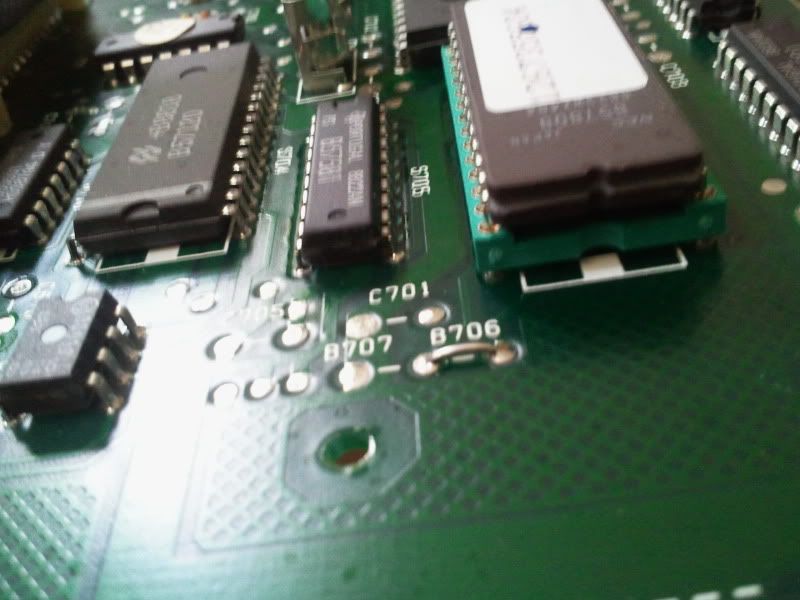
Squadra chip:
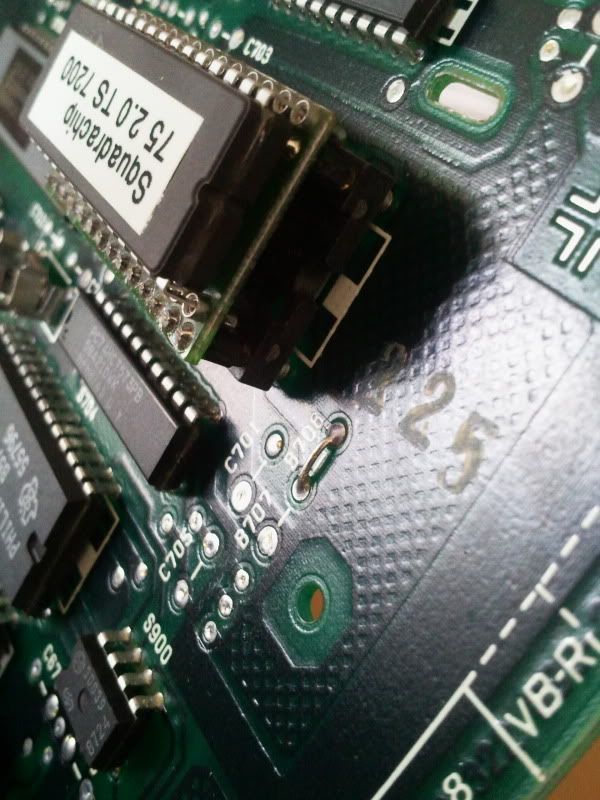
Squadra chip soldered carrier:
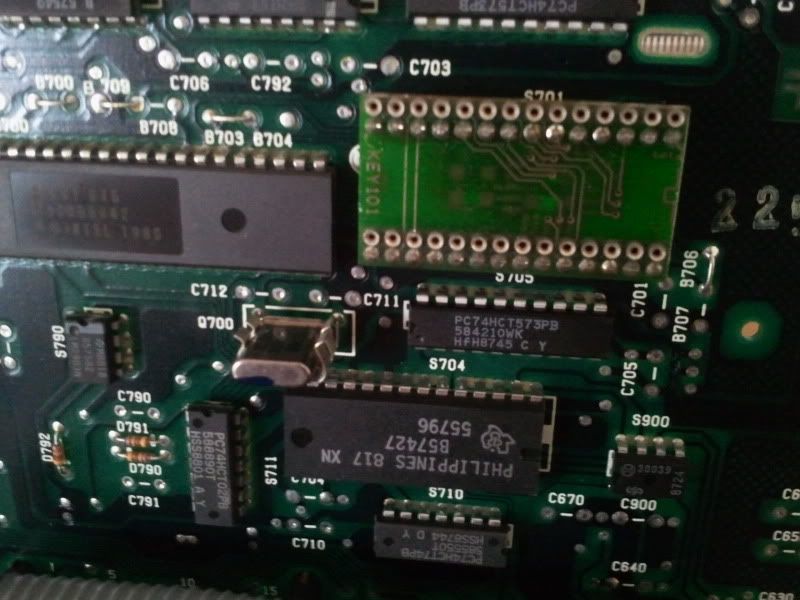
I also noticed two sets of pins that were soldered 'together' behind where the ROM sits... I have tried to circling this in my blurry photos with the red text (older Galaxy S camera) and could not get it to focus particularly well.
Factory unsoldered:
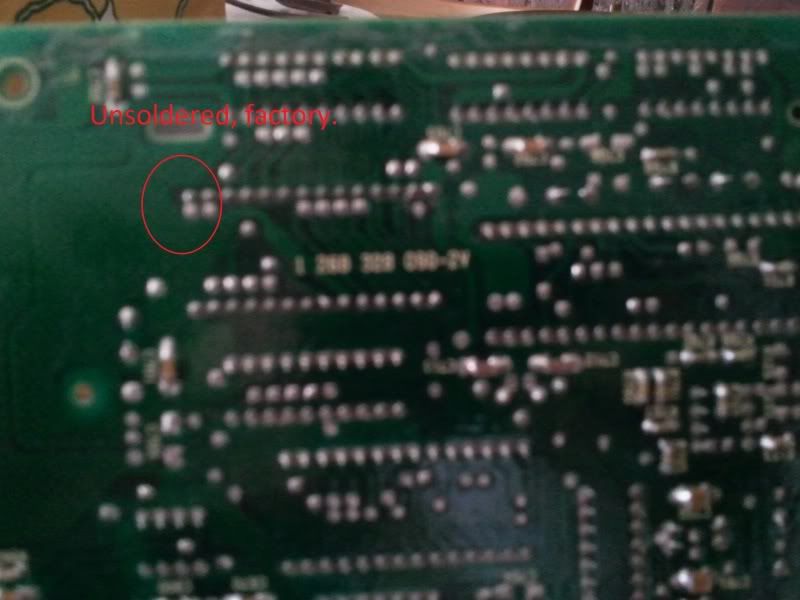
Squadra soldered:
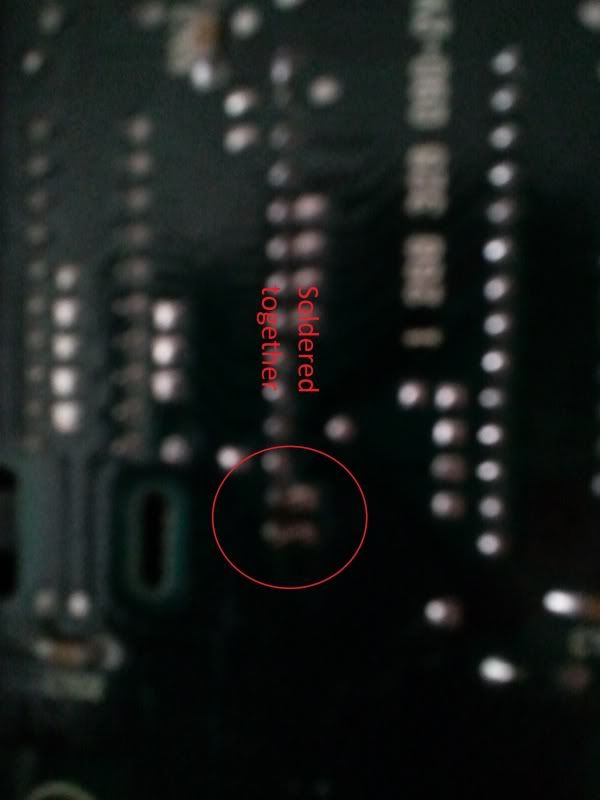
Regards,
InstiTS
Joined
·
520 Posts
Fantastic, thanks for those!
The carrier board for the squadra chip is for copy protection - it shuffles a few of the bus lines around, so if you tried to copy the rom onto another chip you'd get garbage unless you had the right carrier board too.
The soldered pads look like they're just grounding the VPP and A12 lines - there might be something in their code that tests a read at an address that uses the A12 line as a form of copy protection too?
A lot of aftermarket tuners use similar boards to protect their work.
The important thing is that the eproms are socketed.
Instead of trying to hit your limiter, I could send you a chip with a much lower setting (i.e. 3000rpm) - if your engine starts, but tops out at 3k, it would mean I'm on the right track
The carrier board for the squadra chip is for copy protection - it shuffles a few of the bus lines around, so if you tried to copy the rom onto another chip you'd get garbage unless you had the right carrier board too.
The soldered pads look like they're just grounding the VPP and A12 lines - there might be something in their code that tests a read at an address that uses the A12 line as a form of copy protection too?
A lot of aftermarket tuners use similar boards to protect their work.
The important thing is that the eproms are socketed.
Instead of trying to hit your limiter, I could send you a chip with a much lower setting (i.e. 3000rpm) - if your engine starts, but tops out at 3k, it would mean I'm on the right track
ECU cutting edge technology? I would like to see WHO the Bosch competition was back in 1978 (early Motronic) and again who had to offer more sophistication in 1991 than the 164Q4 ecu. Its easy to say their systems are 'slow' today but keep in mind they started the widespread diffusion of efi. I have immense respect for a company that pioneered most if not all car electrical systems in general -not just efi. Subsequently, its natural that once a system is developed, others can only improve on it. For road cars, you can't beat the 'tuneability' of the std system and the reduced cost (in Europe anyway) of dyno mapping, when compared to any aftermarket system.
Jim K.
Jim K.
Joined
·
520 Posts
Yes, the ML4.1 is not cutting edge technology. I didn't say that it wasn't up to scratch back in the day, I said it has it's limitations when compared to today's afternarket ECUs, and wouldn't be the best choice for a high rpm race engine today.
Do you disagree with that?
Do you disagree with that?
No I don't; your statements are correct! Seems that the biggest manufacturers are content with serving the production car market (millions of units) and are not very interested in aftermarket or racing endeavors, unless approached by an equally prestigious entity (like Porsche for example) in which case they do oblige with the best available technology. There's a clear -but imaginary?- line separating oem's from aftermarket efi makers, the latter competing fiercely for features, capability and of course, sales.
Jim K.
Jim K.
Joined
·
1,834 Posts
Nissan had a more than capable system in 1991. Full sequential fuel and ignition for straight and V6, dual knock sensing and single step variable valve timing.ECU cutting edge technology? I would like to see WHO the Bosch competition was back in 1978 (early Motronic) and again who had to offer more sophistication in 1991 than the 164Q4 ecu.
Toyota had about the same.
I'm not saying they were better, but that is what they also had in 1991 and earlier.
GMDelco computers of that era, at least here in Oz, were/are very capable systems. 1 of Holden's tricks to getting very good highway fuel economy from their old tractor engines, was to have a lean cruise mode built into the computer where the car would cruise with mixtures significantly leaner than stoichiometric (think 17:1 AFR's). The computer deliberately ignored the feedback from the oxygen sensor. That all ended when the emissions rules changed and the tests they did, monitored those very driving conditions. So 'improved' emissions uses more fuel..........
Highway fuel economy of the old 3.8 litre Buick push rod dinosaur Commodores was better than the much more modern 3.6 litre quad cam, continuously variable valve timing 'Alloytech' (the slightly larger version of the engine now sold in current Alfa's) engined cars. Most people instantly point their finger at the older engine being somehow better, but ignore or are unaware of the changes in emission laws that mean the newer engines were no longer allowed to use any form of leaner than stoichiometric running condition.
Ford Oz had a very similar system and circumstances.
It's interesting to note that a 1986 model Nissan computer had twice the memory size of the 1990 Motronic that was in my Potenziata.
Nissan were also using hot wire AFM's in 1986 but the Alfa was still using the old vane AFM. My guess would be that poor old broke Alfa Romeo were getting better deals on surplus Bosch parts, more than anything else.
Joined
·
1,834 Posts
Factory systems of the last 10 or so years have MASSIVE capabilities. The only real area that they don't have or need, is the capacity is data logging of external inputs. The sort of data that race teams need to log can't be stored by the factory ECU's.
But as for running the engine in either factory or retuned computer and modified engine, the factory systems are where it's at.
Just so long as there is some form of interface available. And for popular performance cars here in Oz like the WRX's the late model Evo's, LSx powered Holden Commodores and Ford Falcons, there is plenty of support.
You'd be absolutely mad to replace their factory computer on anything other than an out and out track car. Even massively modified ones.
The head electronics engineer at Adaptronic acknowledged that on their own forum. Most people with a vested interest in selling a product like that never would.
But as for running the engine in either factory or retuned computer and modified engine, the factory systems are where it's at.
Just so long as there is some form of interface available. And for popular performance cars here in Oz like the WRX's the late model Evo's, LSx powered Holden Commodores and Ford Falcons, there is plenty of support.
You'd be absolutely mad to replace their factory computer on anything other than an out and out track car. Even massively modified ones.
The head electronics engineer at Adaptronic acknowledged that on their own forum. Most people with a vested interest in selling a product like that never would.
Joined
·
3,589 Posts
This is pretty much off the subject, but I've wondered if the latest direct injection units greatly increase the computing power required for them to function (properly).
I've also wondered if it would be possible to modify the TS head to incorporate these injectors.
I really don't understand how the tips of the injectors can survive in a combustion chamber.
Don't mean to muddy the waters here.
I've also wondered if it would be possible to modify the TS head to incorporate these injectors.
I really don't understand how the tips of the injectors can survive in a combustion chamber.
Don't mean to muddy the waters here.
Joined
·
1,834 Posts
From what I've read about direct Petrol/Gasoline injection, there is a much narrower window of time to inject the fuel into the combustion chamber. The computer needs know exactly where the engine is at any given time. So it needs a lot of processing power and speed.
Ultimately, if its performance you are chasing, there are some MUCH better priced options than trying to create your own direct injection version of an old engine.
Ultimately, if its performance you are chasing, there are some MUCH better priced options than trying to create your own direct injection version of an old engine.
61 - 80 of 817 Posts
-
?
-
?
-
?
-
?
-
?
-
?
-
?
-
?
-
?
-
?
-
?
-
?
-
?
-
?
-
?
-
?
-
?
-
?
-
?
-
?
- posts
- 2.2M
- members
- 94K
- Since
- 2002
A forum community dedicated to Alfa Romeo owners and enthusiasts. Come join the discussion about performance, parts, modifications, troubleshooting, maintenance, and more!





